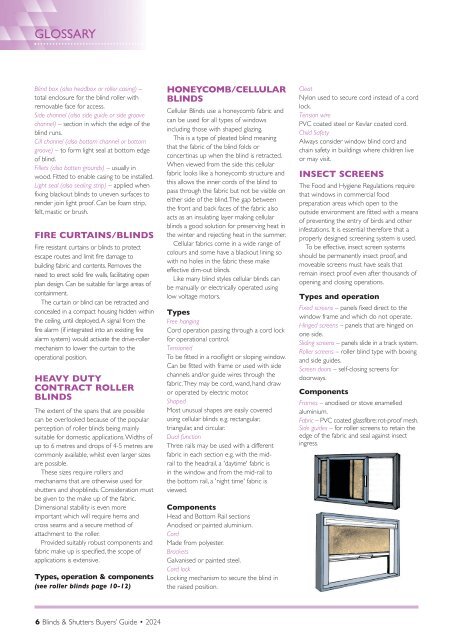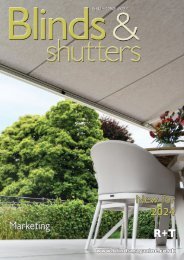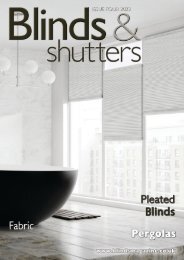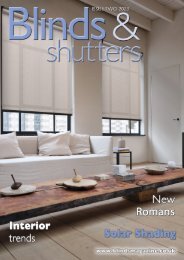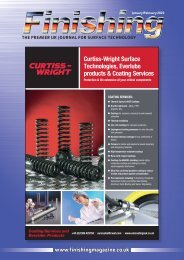Blinds & Shutters Buyers Guide 2024
Welcome to the Blinds & Shutters Buyers’ Guide 2024 the only UK directory for blinds, shutters, awnings and grilles. This is the essential guide for manufacturers, retailers and specifiers such as architects and designers, to source components and finished products. This edition of the Buyers’ Guide contains useful and practical information, such as the revised Glossary; a review of the Smart Buildings Show 2023; Features on new products and the BSI revised list for Relevant Standards. The A-Z Section and Buyers’ Guide Section provides information relating to 450 businesses and 50 different product types. Each year we review the categories in the Buyers’ Guide section. This year we have added Solar blinds in the INTERNAL section to make the guide more comprehensive: We hope that you find this year’s directory an invaluable aid to sourcing suppliers to provide the solution to your specific needs. The Blinds & Shutters team wish you all the very best for 2024!
Welcome to the Blinds & Shutters Buyers’ Guide 2024 the only UK directory for blinds, shutters, awnings and grilles.
This is the essential guide for manufacturers, retailers and specifiers such as architects and designers, to source components and finished products.
This edition of the Buyers’ Guide contains useful and practical information, such as the revised Glossary; a review of the Smart Buildings Show 2023; Features on new products and the BSI revised list for Relevant Standards.
The A-Z Section and Buyers’ Guide Section provides information relating to 450 businesses and 50 different product types.
Each year we review the categories in the Buyers’ Guide section. This year we have added Solar blinds in the INTERNAL section to make the guide more comprehensive:
We hope that you find this year’s directory an invaluable aid to sourcing suppliers to provide the solution to your specific needs.
The Blinds & Shutters team wish you all the very best for 2024!
You also want an ePaper? Increase the reach of your titles
YUMPU automatically turns print PDFs into web optimized ePapers that Google loves.
GLOSSARY<br />
Blind box (also headbox or roller casing) –<br />
total enclosure for the blind roller with<br />
removable face for access.<br />
Side channel (also side guide or side groove<br />
channel) – section in which the edge of the<br />
blind runs.<br />
Cill channel (also bottom channel or bottom<br />
groove) – to form light seal at bottom edge<br />
of blind.<br />
Fillets (also batten grounds) – usually in<br />
wood. Fitted to enable casing to be installed.<br />
Light seal (also sealing strip) – applied when<br />
fixing blackout blinds to uneven surfaces to<br />
render join light proof. Can be foam strip,<br />
felt, mastic or brush.<br />
FIRE CURTAINS/BLINDS<br />
Fire resistant curtains or blinds to protect<br />
escape routes and limit fire damage to<br />
building fabric and contents. Removes the<br />
need to erect solid fire walls, facilitating open<br />
plan design. Can be suitable for large areas of<br />
containment.<br />
The curtain or blind can be retracted and<br />
concealed in a compact housing hidden within<br />
the ceiling, until deployed. A signal from the<br />
fire alarm (if integrated into an existing fire<br />
alarm system) would activate the drive-roller<br />
mechanism to lower the curtain to the<br />
operational position.<br />
HEAVY DUTY<br />
CONTRACT ROLLER<br />
BLINDS<br />
The extent of the spans that are possible<br />
can be overlooked because of the popular<br />
perception of roller blinds being mainly<br />
suitable for domestic applications. Widths of<br />
up to 6 metres and drops of 4-5 metres are<br />
commonly available, whilst even larger sizes<br />
are possible.<br />
These sizes require rollers and<br />
mechanisms that are otherwise used for<br />
shutters and shopblinds. Consideration must<br />
be given to the make up of the fabric.<br />
Dimensional stability is even more<br />
important which will require hems and<br />
cross seams and a secure method of<br />
attachment to the roller.<br />
Provided suitably robust components and<br />
fabric make up is specified, the scope of<br />
applications is extensive.<br />
Types, operation & components<br />
(see roller blinds page 10-12)<br />
HONEYCOMB/CELLULAR<br />
BLINDS<br />
Cellular <strong>Blinds</strong> use a honeycomb fabric and<br />
can be used for all types of windows<br />
including those with shaped glazing.<br />
This is a type of pleated blind meaning<br />
that the fabric of the blind folds or<br />
concertinas up when the blind is retracted.<br />
When viewed from the side this cellular<br />
fabric looks like a honeycomb structure and<br />
this allows the inner cords of the blind to<br />
pass through the fabric but not be visible on<br />
either side of the blind. The gap between<br />
the front and back faces of the fabric also<br />
acts as an insulating layer making cellular<br />
blinds a good solution for preserving heat in<br />
the winter and rejecting heat in the summer.<br />
Cellular fabrics come in a wide range of<br />
colours and some have a blackout lining so<br />
with no holes in the fabric these make<br />
effective dim-out blinds.<br />
Like many blind styles cellular blinds can<br />
be manually or electrically operated using<br />
low voltage motors.<br />
Types<br />
Free hanging<br />
Cord operation passing through a cord lock<br />
for operational control.<br />
Tensioned<br />
To be fitted in a rooflight or sloping window.<br />
Can be fitted with frame or used with side<br />
channels and/or guide wires through the<br />
fabric. They may be cord, wand, hand draw<br />
or operated by electric motor.<br />
Shaped<br />
Most unusual shapes are easily covered<br />
using cellular blinds e.g. rectangular,<br />
triangular, and circular.<br />
Dual function<br />
Three rails may be used with a different<br />
fabric in each section e.g. with the midrail<br />
to the headrail, a 'daytime' fabric is<br />
in the window and from the mid-rail to<br />
the bottom rail, a 'night time' fabric is<br />
viewed.<br />
Components<br />
Head and Bottom Rail sections<br />
Anodised or painted aluminium.<br />
Cord<br />
Made from polyester.<br />
Brackets<br />
Galvanised or painted steel.<br />
Cord lock<br />
Locking mechanism to secure the blind in<br />
the raised position.<br />
Cleat<br />
Nylon used to secure cord instead of a cord<br />
lock.<br />
Tension wire<br />
PVC coated steel or Kevlar coated cord.<br />
Child Safety<br />
Always consider window blind cord and<br />
chain safety in buildings where children live<br />
or may visit.<br />
INSECT SCREENS<br />
The Food and Hygiene Regulations require<br />
that windows in commercial food<br />
preparation areas which open to the<br />
outside environment are fitted with a means<br />
of preventing the entry of birds and other<br />
infestations. It is essential therefore that a<br />
properly designed screening system is used.<br />
To be effective, insect screen systems<br />
should be permanently insect proof, and<br />
moveable screens must have seals that<br />
remain insect proof even after thousands of<br />
opening and closing operations.<br />
Types and operation<br />
Fixed screens – panels fixed direct to the<br />
window frame and which do not operate.<br />
Hinged screens – panels that are hinged on<br />
one side.<br />
Sliding screens – panels slide in a track system.<br />
Roller screens – roller blind type with boxing<br />
and side guides.<br />
Screen doors – self-closing screens for<br />
doorways.<br />
Components<br />
Frames – anodised or stove enamelled<br />
aluminium.<br />
Fabric – PVC coated glassfibre; rot-proof mesh.<br />
Side guides – for roller screens to retain the<br />
edge of the fabric and seal against insect<br />
ingress.<br />
6 <strong>Blinds</strong> & <strong>Shutters</strong> <strong>Buyers</strong>’ <strong>Guide</strong> • <strong>2024</strong>


